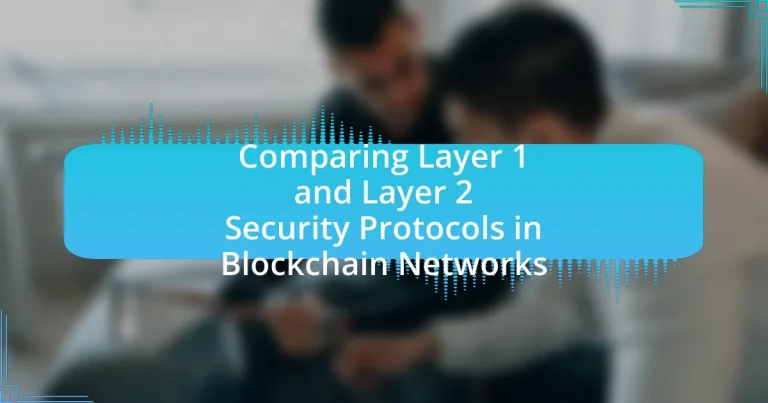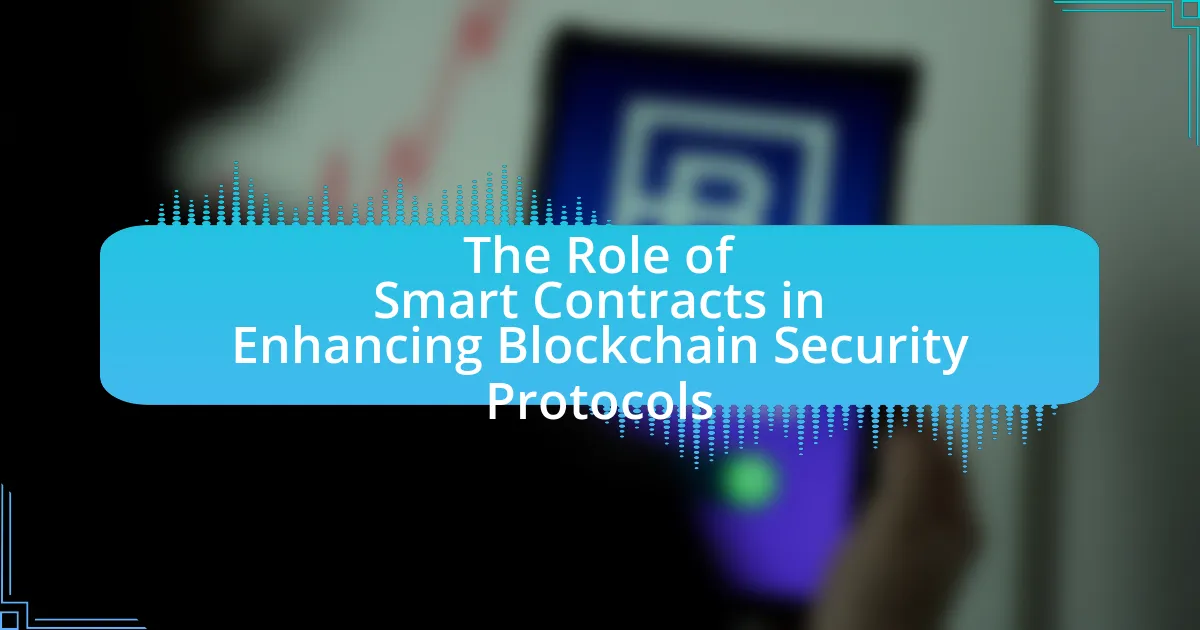Layer 1 and Layer 2 security protocols are essential components of blockchain networks, each serving distinct roles in ensuring transaction integrity and network security. Layer 1 protocols, such as Bitcoin and Ethereum, provide foundational security through consensus mechanisms like Proof of Work and Proof of Stake, while facing challenges related to scalability and transaction speed. Conversely, Layer 2 protocols, including the Lightning Network and Optimistic Rollups, enhance scalability and reduce transaction costs by processing transactions off-chain, but they introduce additional security considerations and potential vulnerabilities. This article compares the characteristics, advantages, and disadvantages of both Layer 1 and Layer 2 security protocols, highlighting their respective impacts on blockchain functionality and user experience.
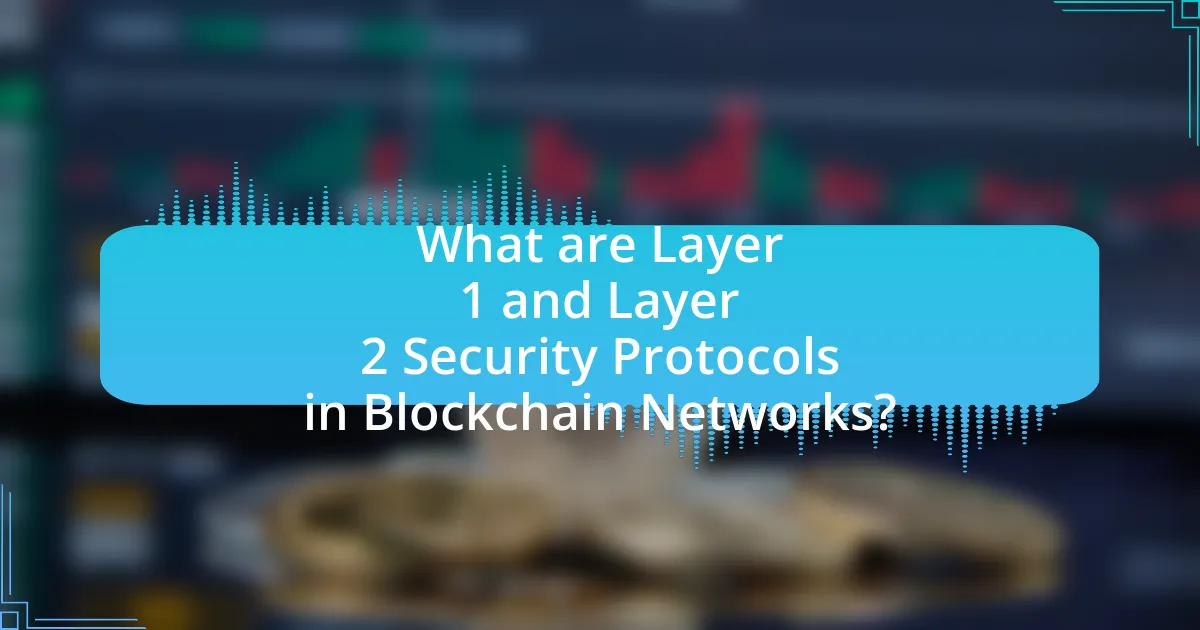
What are Layer 1 and Layer 2 Security Protocols in Blockchain Networks?
Layer 1 security protocols are the foundational security measures implemented directly on the blockchain’s base layer, ensuring the integrity and security of transactions and data. These protocols include consensus mechanisms like Proof of Work and Proof of Stake, which validate transactions and secure the network against attacks. In contrast, Layer 2 security protocols operate on top of the Layer 1 blockchain, enhancing scalability and transaction speed while maintaining security through mechanisms such as state channels and sidechains. For example, the Lightning Network, a Layer 2 solution for Bitcoin, allows for faster transactions while relying on the underlying security of the Bitcoin blockchain. This distinction is crucial as it highlights how Layer 1 provides the core security framework, while Layer 2 enhances functionality without compromising the foundational security established by Layer 1.
How do Layer 1 and Layer 2 differ in their approach to security?
Layer 1 and Layer 2 differ significantly in their approach to security, with Layer 1 focusing on securing the base protocol and Layer 2 enhancing scalability while relying on Layer 1’s security. Layer 1, such as Bitcoin or Ethereum, employs mechanisms like proof of work or proof of stake to ensure the integrity and security of transactions directly on the blockchain. In contrast, Layer 2 solutions, like the Lightning Network or Optimistic Rollups, operate on top of Layer 1 and utilize techniques such as state channels or rollups to process transactions off-chain, which can introduce additional security considerations, such as the need for trust in the Layer 2 protocol and potential vulnerabilities during the transition back to Layer 1. This distinction highlights that while Layer 1 provides foundational security, Layer 2 must implement its own security measures to protect against risks associated with off-chain transactions.
What are the key characteristics of Layer 1 security protocols?
Layer 1 security protocols are foundational mechanisms that ensure the integrity, confidentiality, and availability of blockchain networks. These protocols typically include consensus algorithms, cryptographic techniques, and network governance structures. For instance, proof-of-work and proof-of-stake are common consensus mechanisms that validate transactions and secure the network against attacks. Additionally, cryptographic hashing protects data integrity, while decentralized governance models enhance resilience against single points of failure. These characteristics collectively contribute to the robustness and security of Layer 1 blockchain systems.
What are the key characteristics of Layer 2 security protocols?
Layer 2 security protocols are characterized by their ability to enhance scalability, reduce transaction costs, and maintain security through off-chain solutions. These protocols, such as state channels and sidechains, allow transactions to occur off the main blockchain while still leveraging its security features. For instance, state channels enable participants to conduct multiple transactions without committing each one to the blockchain, thus minimizing congestion and fees. Additionally, Layer 2 solutions often incorporate cryptographic techniques to ensure data integrity and privacy, further reinforcing their security.
Why is security important in blockchain networks?
Security is crucial in blockchain networks because it ensures the integrity, confidentiality, and availability of data. The decentralized nature of blockchain makes it susceptible to various attacks, such as double-spending and Sybil attacks, which can compromise the trustworthiness of the network. For instance, a study by Nakamoto in 2008 highlighted that without robust security measures, the entire system could be undermined, leading to significant financial losses and erosion of user trust. Therefore, implementing strong security protocols is essential to protect against vulnerabilities and maintain the overall functionality of blockchain systems.
What are the common security threats faced by blockchain networks?
Common security threats faced by blockchain networks include 51% attacks, smart contract vulnerabilities, and Sybil attacks. A 51% attack occurs when a single entity gains control of more than half of the network’s mining power, allowing them to manipulate transactions and double-spend coins. Smart contract vulnerabilities arise from coding errors or flaws in the contract logic, which can be exploited by malicious actors, leading to financial losses. Sybil attacks involve an attacker creating multiple identities to gain influence over the network, potentially disrupting consensus mechanisms. These threats are well-documented in various studies, including the “Security and Privacy Issues in Blockchain Technology” report by M. A. Alzahrani et al., which highlights the prevalence and impact of these vulnerabilities on blockchain integrity.
How do security protocols mitigate these threats?
Security protocols mitigate threats in blockchain networks by implementing cryptographic techniques, consensus mechanisms, and access controls. These measures ensure data integrity, confidentiality, and availability, which are essential for protecting against attacks such as double spending, Sybil attacks, and unauthorized access. For instance, cryptographic hashing secures transaction data, making it tamper-proof, while consensus algorithms like Proof of Work or Proof of Stake validate transactions and prevent malicious activities. Additionally, access controls limit user permissions, reducing the risk of insider threats. These combined strategies create a robust security framework that effectively addresses vulnerabilities in both Layer 1 and Layer 2 protocols.
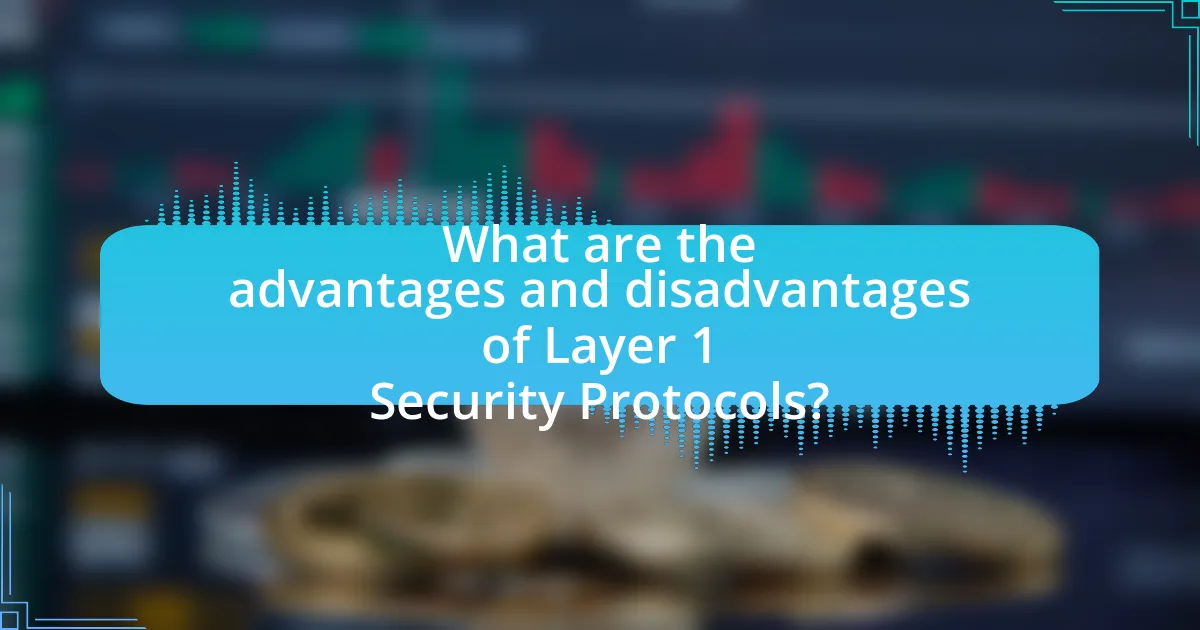
What are the advantages and disadvantages of Layer 1 Security Protocols?
Layer 1 Security Protocols offer robust security directly at the blockchain level, ensuring that all transactions are validated and secured without reliance on additional layers. The advantages include enhanced security against attacks such as double spending and Sybil attacks, as they utilize consensus mechanisms like Proof of Work or Proof of Stake, which are integral to the blockchain’s operation. However, the disadvantages involve scalability issues, as Layer 1 solutions can become congested with high transaction volumes, leading to slower processing times and higher fees. Additionally, implementing changes or upgrades to Layer 1 protocols can be complex and may require consensus from the entire network, making it less adaptable compared to Layer 2 solutions.
What benefits do Layer 1 security protocols provide?
Layer 1 security protocols provide foundational security for blockchain networks by ensuring the integrity, availability, and confidentiality of transactions. These protocols protect against various attacks, such as double-spending and Sybil attacks, by utilizing consensus mechanisms like Proof of Work or Proof of Stake, which validate transactions and secure the network. For instance, Bitcoin’s Proof of Work mechanism has demonstrated resilience against attacks, maintaining network integrity since its inception in 2009. Additionally, Layer 1 protocols often incorporate cryptographic techniques to secure user data and transaction details, further enhancing overall security.
How do Layer 1 protocols ensure data integrity?
Layer 1 protocols ensure data integrity through mechanisms such as consensus algorithms, cryptographic hashing, and decentralized validation. Consensus algorithms, like Proof of Work or Proof of Stake, require network participants to agree on the validity of transactions before they are added to the blockchain, thereby preventing double-spending and ensuring that only legitimate transactions are recorded. Cryptographic hashing secures data by transforming transaction information into a fixed-size string, making it tamper-evident; any alteration in the data would result in a completely different hash, alerting the network to potential fraud. Additionally, the decentralized nature of Layer 1 protocols means that multiple nodes validate transactions independently, further enhancing data integrity by reducing the risk of a single point of failure or manipulation.
What are the scalability challenges associated with Layer 1 protocols?
Layer 1 protocols face significant scalability challenges primarily due to their limited transaction throughput and high latency. These protocols, such as Bitcoin and Ethereum, often struggle to process a large number of transactions simultaneously, leading to network congestion. For instance, Bitcoin can handle approximately 7 transactions per second, while Ethereum processes around 30 transactions per second, which is insufficient for mass adoption. This limitation results in increased transaction fees and longer confirmation times during peak usage periods, as seen during the 2017 crypto boom when Ethereum gas fees surged to over $50. Additionally, the consensus mechanisms employed, like Proof of Work, require substantial computational resources, further hindering scalability.
What limitations do Layer 1 security protocols have?
Layer 1 security protocols have limitations in scalability, flexibility, and transaction speed. These protocols often struggle to handle a high volume of transactions simultaneously, leading to congestion and increased fees during peak usage times. For instance, Bitcoin’s Layer 1 can process approximately 7 transactions per second, which is significantly lower than many Layer 2 solutions. Additionally, Layer 1 protocols are generally less adaptable to changes or upgrades, making it challenging to implement new features without significant network disruptions. This rigidity can hinder innovation and responsiveness to evolving security threats.
How do transaction speeds compare with Layer 2 solutions?
Transaction speeds with Layer 2 solutions are significantly faster than those of Layer 1 protocols. Layer 2 solutions, such as the Lightning Network for Bitcoin or Optimistic Rollups for Ethereum, can process thousands of transactions per second, while Layer 1 networks typically handle only a limited number, often ranging from 7 to 30 transactions per second. For instance, Ethereum’s Layer 1 can process around 15 transactions per second, whereas Layer 2 solutions can achieve speeds exceeding 2,000 transactions per second, demonstrating a substantial improvement in efficiency and scalability.
What are the costs associated with implementing Layer 1 security?
The costs associated with implementing Layer 1 security primarily include infrastructure expenses, development costs, and ongoing maintenance fees. Infrastructure expenses can range from hardware procurement to network setup, often requiring significant investment in servers and nodes to ensure robust security. Development costs involve hiring skilled developers and security experts to design and implement security protocols, which can be substantial, especially for complex systems. Ongoing maintenance fees include costs for monitoring, updates, and incident response, which are essential to maintain security integrity over time. These costs can vary widely based on the scale of the blockchain network and the specific security measures adopted.
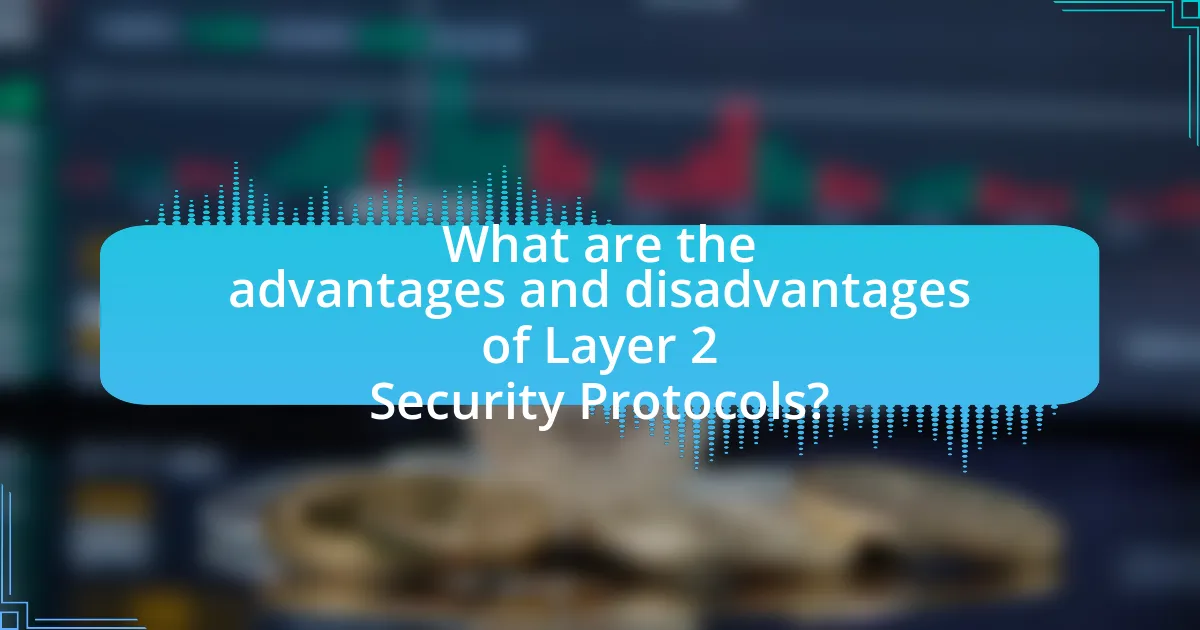
What are the advantages and disadvantages of Layer 2 Security Protocols?
Layer 2 Security Protocols offer enhanced scalability and reduced transaction costs, but they also introduce potential vulnerabilities and complexity. The scalability advantage arises from offloading transactions from the main blockchain, allowing for faster processing and lower fees, which is evidenced by the success of protocols like the Lightning Network for Bitcoin. However, the disadvantages include increased reliance on the security of the underlying Layer 1 protocol and the risk of centralization, as some Layer 2 solutions may require trusted intermediaries. Additionally, the complexity of integrating Layer 2 solutions can lead to implementation challenges and potential security loopholes.
How do Layer 2 security protocols enhance scalability?
Layer 2 security protocols enhance scalability by offloading transactions from the main blockchain, allowing for increased throughput and reduced congestion. These protocols, such as state channels and rollups, enable multiple transactions to be processed off-chain while maintaining security through cryptographic proofs and periodic settlement on the main chain. For instance, Ethereum’s rollups can process thousands of transactions per second, significantly improving scalability compared to Layer 1 solutions, which are often limited by block size and time constraints. This off-chain processing reduces the load on the main blockchain, facilitating faster transaction confirmations and lower fees, thereby enhancing overall network efficiency.
What mechanisms do Layer 2 protocols use to secure transactions?
Layer 2 protocols secure transactions primarily through mechanisms such as state channels, rollups, and sidechains. State channels allow participants to conduct multiple transactions off-chain while only recording the final state on the main blockchain, reducing congestion and enhancing privacy. Rollups bundle multiple transactions into a single one, which is then submitted to the main chain, ensuring that the security of the main chain is leveraged. Sidechains operate independently but are pegged to the main chain, allowing for secure asset transfers while maintaining separate consensus mechanisms. These methods collectively enhance transaction speed and reduce costs while ensuring security through cryptographic proofs and the underlying security of the main blockchain.
How do Layer 2 solutions impact user experience?
Layer 2 solutions significantly enhance user experience by improving transaction speed and reducing costs. These solutions, such as state channels and rollups, allow for off-chain processing, which alleviates congestion on the main blockchain. For instance, Ethereum’s Layer 2 solutions can process thousands of transactions per second compared to the main chain’s limitations, resulting in faster confirmations and lower fees. This improvement directly addresses user pain points, making blockchain applications more accessible and efficient for everyday use.
What challenges do Layer 2 security protocols face?
Layer 2 security protocols face challenges such as scalability, interoperability, and susceptibility to attacks. Scalability issues arise because as Layer 2 solutions handle more transactions, maintaining security without compromising speed becomes difficult. Interoperability challenges occur when different Layer 2 solutions need to communicate with each other or with Layer 1, leading to potential vulnerabilities. Additionally, Layer 2 protocols can be susceptible to specific attacks, such as fraud proofs and denial-of-service attacks, which can exploit the trust assumptions made in these systems. These challenges highlight the need for ongoing research and development to enhance the security and efficiency of Layer 2 solutions in blockchain networks.
How do interoperability issues affect Layer 2 solutions?
Interoperability issues significantly hinder the effectiveness of Layer 2 solutions by limiting their ability to communicate and operate seamlessly across different blockchain networks. These issues arise when Layer 2 solutions, designed to enhance scalability and transaction speed, cannot easily interact with Layer 1 blockchains or other Layer 2 solutions, resulting in fragmented ecosystems. For instance, if a Layer 2 solution on Ethereum cannot integrate with a Layer 2 solution on a different blockchain, users face challenges in transferring assets or executing cross-chain transactions, which undermines the overall utility and adoption of these solutions. This lack of interoperability can lead to increased transaction costs, reduced user experience, and ultimately, a slower pace of innovation within the blockchain space.
What are the potential vulnerabilities in Layer 2 protocols?
Layer 2 protocols face several potential vulnerabilities, including security risks associated with smart contracts, reliance on the underlying Layer 1 blockchain, and issues related to network congestion. Smart contracts can contain bugs or vulnerabilities that attackers may exploit, leading to financial losses. Additionally, Layer 2 solutions often depend on the security of the Layer 1 blockchain; if the base layer is compromised, Layer 2 protocols may also be at risk. Network congestion can lead to delays and increased transaction costs, which may be exploited by malicious actors to perform denial-of-service attacks. These vulnerabilities highlight the need for robust security measures in the design and implementation of Layer 2 protocols.
How do Layer 1 and Layer 2 security protocols compare in practice?
Layer 1 security protocols provide the foundational security for blockchain networks by securing the base layer through consensus mechanisms like Proof of Work or Proof of Stake, while Layer 2 security protocols enhance scalability and transaction speed without compromising the underlying security. In practice, Layer 1 protocols, such as Bitcoin and Ethereum, ensure the integrity and immutability of the blockchain, but may face scalability issues, leading to higher transaction fees and slower processing times during peak usage. Conversely, Layer 2 solutions, like the Lightning Network for Bitcoin or Optimistic Rollups for Ethereum, allow for off-chain transactions that are later settled on the Layer 1 chain, thus improving transaction throughput and reducing costs while still relying on the security guarantees of the Layer 1 protocol. This layered approach allows for a balance between security and efficiency, as Layer 2 solutions can inherit the security properties of Layer 1 while providing enhanced performance.
What are the real-world examples of Layer 1 and Layer 2 implementations?
Real-world examples of Layer 1 implementations include Bitcoin and Ethereum, which serve as foundational blockchain networks with their own native protocols and consensus mechanisms. Bitcoin utilizes the Proof of Work consensus algorithm, while Ethereum has transitioned to Proof of Stake with Ethereum 2.0, enhancing scalability and security.
Layer 2 implementations include the Lightning Network for Bitcoin and the Polygon network for Ethereum. The Lightning Network enables faster transactions and lower fees by creating off-chain payment channels, while Polygon enhances Ethereum’s scalability by providing a framework for building and connecting Layer 2 chains, allowing for faster and cheaper transactions.
How do developers choose between Layer 1 and Layer 2 solutions?
Developers choose between Layer 1 and Layer 2 solutions based on scalability, transaction speed, and cost-effectiveness. Layer 1 solutions, such as Bitcoin and Ethereum, provide a base protocol that ensures security and decentralization but may face limitations in transaction throughput and speed. In contrast, Layer 2 solutions, like the Lightning Network for Bitcoin or Optimistic Rollups for Ethereum, enhance scalability by processing transactions off the main chain, allowing for faster and cheaper transactions. Developers assess the specific needs of their applications, such as the required transaction volume and user experience, to determine which solution best aligns with their goals. For instance, Ethereum’s transition to Layer 2 solutions has been driven by the need to accommodate increasing user demand while maintaining network security.
What best practices should be followed when implementing security protocols in blockchain networks?
When implementing security protocols in blockchain networks, best practices include conducting thorough risk assessments, utilizing cryptographic techniques, and ensuring regular software updates. Risk assessments help identify vulnerabilities specific to the network’s architecture, whether Layer 1 or Layer 2, enabling targeted security measures. Cryptographic techniques, such as hashing and digital signatures, provide data integrity and authentication, which are essential for maintaining trust in the network. Regular software updates are crucial as they address known vulnerabilities and enhance security features, thereby protecting against emerging threats. According to the Blockchain Security Framework by the National Institute of Standards and Technology (NIST), these practices are fundamental for establishing a secure blockchain environment.
How can organizations assess their security needs effectively?
Organizations can assess their security needs effectively by conducting a comprehensive risk assessment that identifies vulnerabilities, threats, and the potential impact of security breaches. This process involves evaluating existing security measures, understanding the specific assets that need protection, and analyzing the regulatory requirements relevant to their industry. According to a study by the National Institute of Standards and Technology (NIST), organizations that implement a structured risk management framework can significantly enhance their security posture and resilience against cyber threats.
What role does community feedback play in enhancing security protocols?
Community feedback plays a crucial role in enhancing security protocols by providing real-time insights and identifying vulnerabilities that may not be apparent to developers. Engaging with users allows for the collection of diverse perspectives, which can lead to the discovery of potential security flaws and the development of more robust solutions. For instance, platforms like GitHub utilize community contributions to improve code security, as evidenced by the increased number of reported vulnerabilities and subsequent patches following user feedback. This collaborative approach not only strengthens the security framework but also fosters trust within the community, ultimately leading to more resilient blockchain networks.












